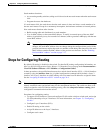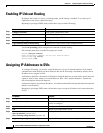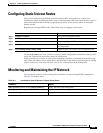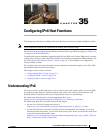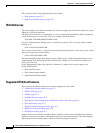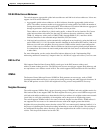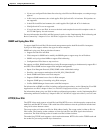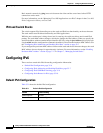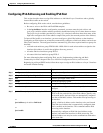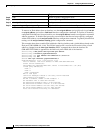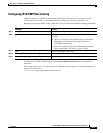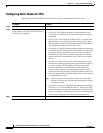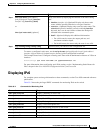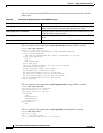
35-5
Catalyst 2960 and 2960-S Switch Software Configuration Guide
OL-8603-09
Chapter 35 Configuring IPv6 Host Functions
Understanding IPv6
• If you try to configure IPv6 without first selecting a dual IPv4 and IPv6 template, a warning message
appears.
• In IPv4-only environments, the switch applies IPv4 QoS and ACLs in hardware. IPv6 packets are
not supported.
• In dual IPv4 and IPv6 environments, the switch applies IPv4 QoS and ACLs in hardware.
• IPv6 QoS and ACLs are not supported.
• If you do not plan to use IPv6, do not use the dual stack template because this template results in
less TCAM capacity for each resource.
For more information about IPv4 and IPv6 protocol stacks, see the “Implementing IPv6 Addressing and
Basic Connectivity” chapter of Cisco IOS IPv6 Configuration Library on Cisco.com.
SNMP and Syslog Over IPv6
To support both IPv4 and IPv6, IPv6 network management requires both IPv6 and IPv4 transports.
Syslog over IPv6 supports address data types for these transports.
SNMP and syslog over IPv6 provide these features:
• Support for both IPv4 and IPv6
• IPv6 transport for SNMP and to modify the SNMP agent to support traps for an IPv6 host
• SNMP- and syslog-related MIBs to support IPv6 addressing
• Configuration of IPv6 hosts as trap receivers
For support over IPv6, SNMP modifies the existing IP transport mapping to simultaneously support IPv4
and IPv6. These SNMP actions support IPv6 transport management:
• Opens User Datagram Protocol (UDP) SNMP socket with default settings
• Provides a new transport mechanism called SR_IPV6_TRANSPORT
• Sends SNMP notifications over IPv6 transport
• Supports SNMP-named access lists for IPv6 transport
• Supports SNMP proxy forwarding using IPv6 transport
• Verifies SNMP Manager feature works with IPv6 transport
For information on SNMP over IPv6, including configuration procedures, see the “Managing Cisco IOS
Applications over IPv6” chapter in the Cisco IOS IPv6 Configuration Library on Cisco.com.
For information about syslog over IPv6, including configuration procedures, see the “Implementing IPv6
Addressing and Basic Connectivity” chapter in the Cisco IOS IPv6 Configuration Library on Cisco.com.
HTTP(S) Over IPv6
The HTTP client sends requests to both IPv4 and IPv6 HTTP servers, which respond to requests from
both IPv4 and IPv6 HTTP clients. URLs with literal IPv6 addresses must be specified in hexadecimal
using 16-bit values between colons.
The accept socket call chooses an IPv4 or IPv6 address family. The accept socket is either an IPv4 or
IPv6 socket. The listening socket continues to listen for both IPv4 and IPv6 signals that indicate a
connection. The IPv6 listening socket is bound to an IPv6 wildcard address.
The underlying TCP/IP stack supports a dual-stack environment. HTTP relies on the TCP/IP stack and
the sockets for processing network-layer interactions.



